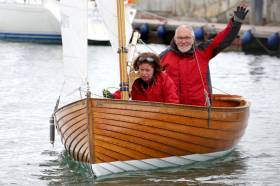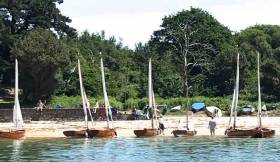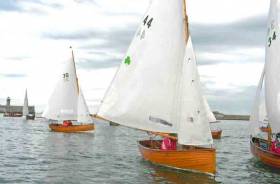Displaying items by tag: Water Wag
Nin O’Leary & Alex Thomson Share The Stage with History in Dun Laoghaire
The rapidly-developing partnership between solo offshore veteran Alex Thomson and proven star of fully-crewed boats Nin O’Leary of Cork has been the focus of much attention this week as they visit Cork and Dun Laoghaire.
Thomson’s eye-catching IMOCA 60 Hugo Boss was leader for significant stages in the 2016-2017 Vendee Globe Race, and placed second at the finish in January. During August, his linkup with Crosshaven’s Nin O’Leary and the new Cork-based set–up of Ireland Ocean Racing has had the rumour mills running in overdrive, with much speculation and comment. W M Nixon found that the unique position of Dun Laoghaire provided a special occasion and a relaxed setting in which the prospects for this new and dynamic sailing relationship could be quietly and usefully discussed.
Every so often, the rest of us who sail from other ports are reminded that, in the final analysis, Dun Laoghaire is our sailing capital. Cork Harbour may be very much the national maritime centre, with Galway also making notable research input. But the extensive nature of Cork Harbour is such that it has several places and organisations which could claim to be its main focal point, so the effect is diffused. And while Galway successfully punches way above its weight, the fact that as a city it is only a fraction of the size of Dublin inevitably counts in rating its influence.
Thus Dublin is very much the capital, the place where major decisions are taken in all national areas including the maritime sphere. Dublin Bay is the main area for its sailing, well ahead in the numbers game. And Dun Laoghaire is uniquely the focal point for that sailing, a remarkable and historic artificial harbour through which the pulsing metropolitan energy interacts with the sea and recreational seafaring.
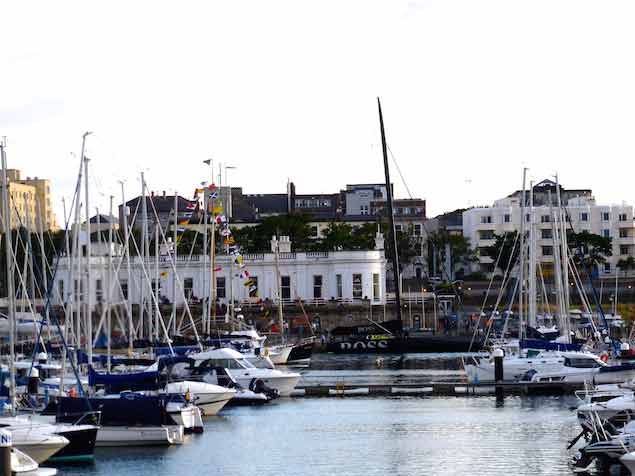 The brooding presence. The all-black IMOCA 60 Hugo Boss berthed at the Royal Irish Yacht Club. Photo: W M Nixon
The brooding presence. The all-black IMOCA 60 Hugo Boss berthed at the Royal Irish Yacht Club. Photo: W M Nixon
Yet at a different level, it is also the home port of many hobby sailors who simply see it as the conveniently-located local harbour which has ample facilities for their own sailing needs. Admittedly the affluence of the area in which it is located has meant that Dun Laoghaire has seen a significant influx of new non-woooden boats over the years, and it has lost some of the historic local One-Design classes which were once the bedrock of its highly-developed sailing scene. But even here, once it became clear that an important heritage was under threat, there has been a growing movement to preserve and expand the most historic class of all.
That has succeeded with the current great good health of the Dublin Bay Water Wag, the world’s first One-Design class, which started life as a simple double-ended little slip of a lug-rigged 13ft sailing dinghy in 1887, but by 1900 was in process of changing itself into a heftier transom-sterned gunter-sloop-rigged clinker-built boat 14ft 3ins long and 5ft 3 ins beam, with a heavy centreplate.
The new design commission was entrusted to boatbuilder J. E. Doyle in what was then Kingstown, but it’s generally reckoned the real designer was his daughter Maimie Doyle, whose talent lay in putting manners on her father’s extremely rough and often nonexistent sketches.
Whatever the design origins, the new boats were soon popular. But with other larger One-Designs available locally, each with its own adherents, it was thought good going if the racing turnout for the new Water Wags climbed above the fifteen mark before the Great War of 1914-1918.
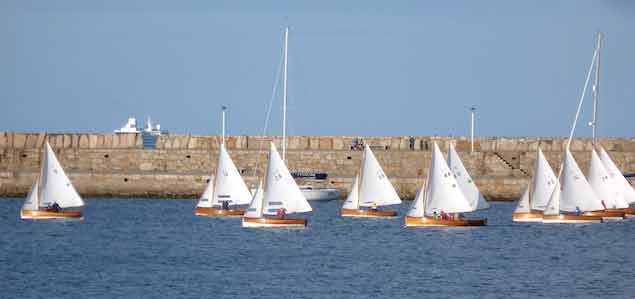 Race on! The Water Wags and Dun Laoghaire Harbour seem made for each other. Photo: W M Nixon
Race on! The Water Wags and Dun Laoghaire Harbour seem made for each other. Photo: W M Nixon
Dublin Bay proved to be ideal for the encouragement of several One-Design classes, but over the years the classic larger wooden boats left the stage to be replaced by more modern plastic boats, with the Dublin Bay 21s exiting in 1986, while in 2004 the Dublin Bay 24s sailed their last race, yet today it could be argued that they’ve been replaced by the growing Dublin Bay J/109 fleet.
A couple of post-World War II timber-built classes are still active in the Glens and the IDRA 14s, but the 17ft Dublin Bay Mermaids of 1932 provenance which originated in Dun Laoghaire are only a token presence, even if they thrive elsewhere. So now the main thrust of Dun Laoghaire enthusiasm for genuine classics sailing has devolved on the Water Wags, which today prosper as never before, and in 2017 with noted maritime historian Hal Sisk as the very active Class Captain, it was hoped they might finally achieve a racing turnout of 30 boats on the starting line.
One hundred and thirty years to become an overnight success? It could only happen in Dun Laoghaire. But as the Water Wags have been such a key part of the sailing fabric of this great harbour for so long, those in the know were well aware that the evening of Wednesday 30th August was the date set for the very special big push, the extra effort towards topping the thirty mark with the racing for the Captain’s Prize, with the fleet including helms and crews with Olympic experience.
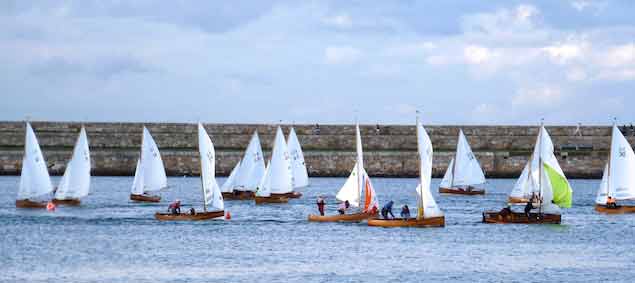 With the class rules’ insistence that spinnakers be set classical style entirely to weather, speed of setting varies enormously. Photo: W M Nixon
With the class rules’ insistence that spinnakers be set classical style entirely to weather, speed of setting varies enormously. Photo: W M Nixon
That racing in turn would be rounded out by a dinner held in the Captain’s own club to end the season’s evening racing. The Water Wags’ home bases are spread along the three older waterfront clubs, so the Captain’s Prize dinner 2017 was already scheduled for Hal’s own club, the Royal Irish, when news emerged that the mighty Hugo Boss, with the new Thomson/O’Leary combo on board, hoped to visit Dun Laoghaire for a couple of days in the last week of August, and could the RIYC accommodate their promotional needs to be seen, be accessible, and provide a base for shore entertainment?
The visit would clash either with the Water Wags special race on Wednesday, or with the regular big-turnout Dublin Bay Sailing Club keelboat racing on Thursday. It fell to the RIYC’s Rear Commodore (House) Jacqueline McStay to decide how to play it, and she played a blinder.
Where others saw a problem, she saw an opportunity. She suggested that the planned dinners for the Water Wags and those involved with Hugo Boss should be turned into one single free-form event, using the RIYC’s historic dining room and spreading into the drawing room next door. She further suggested that as the Water Wags had seniority, Hal Sisk should be the main – indeed, possibly the only - speaker at the actual dinner.
But then, with a touch of genius, she suggested that while the Water Wags were out racing, it would be ever so obliging if Alex, Nin, and their genius boffin-organiser Stewart Hosford could give a little presentation to an audience of members and friends, in the club’s extensive basement room, about themselves, their own plans, and the boat’s movements in the weeks, months and maybe years ahead.
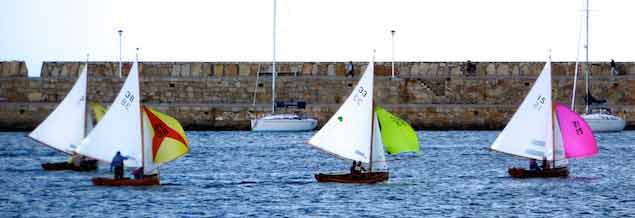 The leaders begin to emerge from the pack, with eventual winner Moosmie leading from Eva (33, Katie Tingle & Dermot O’Flynn), Swift (38, Guy Kilroy, sailed by David Somerville) and Pansy (3, Vincent Delany) Photo: W M Nixon
The leaders begin to emerge from the pack, with eventual winner Moosmie leading from Eva (33, Katie Tingle & Dermot O’Flynn), Swift (38, Guy Kilroy, sailed by David Somerville) and Pansy (3, Vincent Delany) Photo: W M Nixon
It was a masterplan for non-stop nautical entertainment for about six hours, beginning with the sniff around the Hugo Boss (“mighty machine” is an inadequate phrase here) followed by seeing the early stages of the Water Wags’ historic race, then breaking away to take in the presentation by the Talented Three in the basement, followed by the dinner when history and modernity got together, with the enjoyment of this providing a relaxed atmosphere for the exchange of information.
Pessimists would reckon this complex programme for one night in one club had endless opportunities for the wheels to come off, but it went so well you’d swear they did this sort of thing at least five nights a week. As with all Irish events of an outdoor/indoor nature, the Great Imponderable was the weather, and the forecast 24 hours earlier wasn’t at all cheerful. Yet despite that they managed to rouse out a world record of 31 “new” Water Wags, and the photos say everything about perfect conditions for the last evening race of the summer.
 A shared harbour. Trainee crew out for the evening with St Michael’s Rowing Club.Photo: W M Nixon
A shared harbour. Trainee crew out for the evening with St Michael’s Rowing Club.Photo: W M Nixon
It also provided ideal circumstances for a consideration of the current condition of Dun Laoghaire. The place isn’t helped by being in a state of limbo. I’d optimistically hoped that I could get a good shoreside overview of the race by somehow getting myself to the end of St Michael’s Pier at mid-harbour, but it’s still all blocked off as they battle back and forth about the provision or otherwise of a liner berth.
In other words, the shoreside of the harbour is basically inaccessible to the public except down the marina breakwater, but even that limited viewpoint showed that this was a race in a million. And the quality of construction of the main harbour is such that it’s a joy to behold on such an evening, while within it the Water Wags shared the space with skiffs of St Michael’s Rowing Club and boats out from the Irish National Sailing School. Conditions improved as the race went along, with a freshening breeze sharpened up by a long black cloud which moved slowly over towards Howth, leaving crisp evening sunshine behind it, and a markedly veering breeze for the final beat of a four leg windward-leeward course.
 Moosmie (15) seems to have it nicely under control going over to the tricky west side of the harbour…….Photo: W M Nixon
Moosmie (15) seems to have it nicely under control going over to the tricky west side of the harbour…….Photo: W M Nixon
 ……but finds herself at the weather mark temporarily behind Swift (38, Guy Kilroy sailed by David Somerville) and Pansy (3, Vincent Delany) Photo: W M Nixon
……but finds herself at the weather mark temporarily behind Swift (38, Guy Kilroy sailed by David Somerville) and Pansy (3, Vincent Delany) Photo: W M Nixon
 Moosmie clear ahead again. Photo: W M Nixon
Moosmie clear ahead again. Photo: W M Nixon
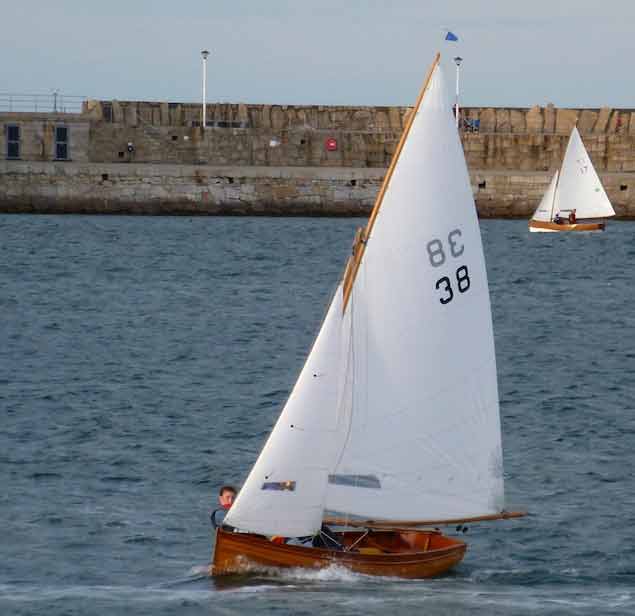 Modern sail-making materials have greatly improved the appearance of the Water Wags. With cotton sails, they often had a starved look, but today’s sailplan looks well fed. This is Guy Kilroy’s 2001-built Swift raced on Wednesday to fifth place by David Somerville. Photo: W M Nixon
Modern sail-making materials have greatly improved the appearance of the Water Wags. With cotton sails, they often had a starved look, but today’s sailplan looks well fed. This is Guy Kilroy’s 2001-built Swift raced on Wednesday to fifth place by David Somerville. Photo: W M Nixon
Thus although David and Sally MacFarlane in the 107-year-old Moosmie (no 15) had overcome a setback or two to retain the lead and sometimes show well clear ahead, the finish came with a bit of a rush of boats in from the right hand side of the beat. While Cathy MacAleavey and Con Murphy were second across in her new Mariposa, finish signal came there none - they’d been OCS. But it was the night of nights for the class’s only Howth owners, Ian & Judith Malcolm with the 102-year-old Barbara. They’d been 21st round the leeward mark, but went onto port and headed straight at that black cloud sitting plumb over their house on the southwestern flanks of the Hill of Howth.
They got themselves a mighty freeing for the tack to starboard, and came roaring in toward the finish picking off places by the handful, and finding that the leaders for much of the race were in a bit of a tangle towards the line. So they weathered the lot of them and swept in to take a neat second, making it non-Dun Laoghaire sailors in two of the top places for this Race of Races, as Katie Tingle of Cork was third and winner of IB with Eva, crewed by Dermot O’Flynn.
 Back to base. Hugo Boss waiting to welcome William Prentice & Moiselle Hogan’s Tortoise (42, built 2006, placed 4th) and winner Mousmie (built 1910) as they return to the Royal Irish YC. Photo: W M Nixon
Back to base. Hugo Boss waiting to welcome William Prentice & Moiselle Hogan’s Tortoise (42, built 2006, placed 4th) and winner Mousmie (built 1910) as they return to the Royal Irish YC. Photo: W M Nixon
 Help is always welcome when hauling a Water Wag on the slip, even at high water. Photo: W M Nixon
Help is always welcome when hauling a Water Wag on the slip, even at high water. Photo: W M Nixon
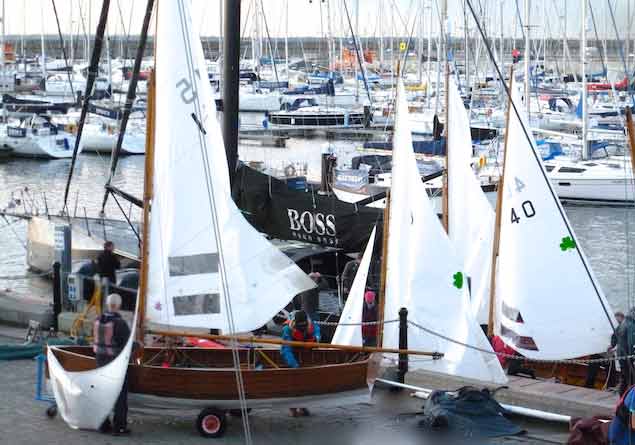 The perfect evening. The winner Moosmie (foreground) is un-rigged after being the first to win from 30 other boats, and Hugo Boss is there to see it all happen. Photo: W M Nixon
The perfect evening. The winner Moosmie (foreground) is un-rigged after being the first to win from 30 other boats, and Hugo Boss is there to see it all happen. Photo: W M Nixon
It’s a good idea to do well in the racing, as it lessens your queuing time to get up the club slips. The atmosphere around the Water Wags is so basically light-hearted – even when they’re hauling these quite heavy little boats back up the slip – that it took a while to adjust to the next mood-stage of the evening, the underlying utter seriousness involved in racing an IMOCA 60 like Hugo Boss, and particularly in such totally extreme sport as the Vendee Globe Race. Alex Thomson does a wonderful line in light-hearted patter, but what he does is mind-blowingly all-involving, and as he talked us through the financial, physical and most importantly psychological requirements for anyone even beginning to contemplate such a thing, you were left in bewilderment in grasping the scale of it all.
As to the matter of how and why he moves about the boat without being apparently concerned about being directly attached to her, he created a certain silence by saying that as you’re often sailing at 25 knots, going overboard on the end of a wire or something similar would bring the certainty of getting dragged to a particularly nasty drowning death.
Only a hundred or so people have managed to sail round the world non-stop, so there’s a real sense of community among those who have done it, and they in turn respect those who have made a whole-hearted attempt to do the same. A real high-point came when Enda O Coineen burst out of the audience and went forward to present his old mate Alex Thomson with a replacement cap for one which had been exchanged a long time ago.
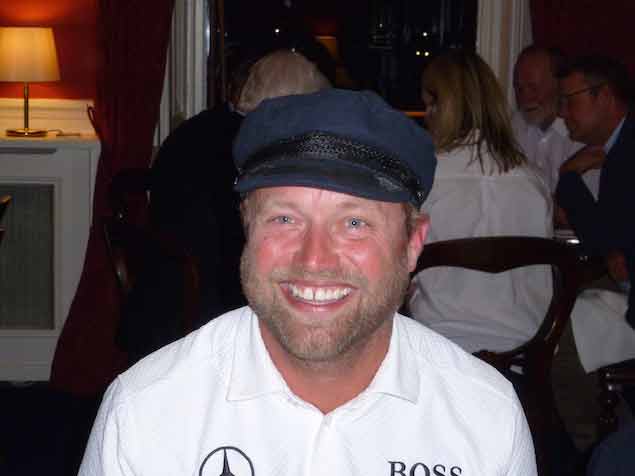 Alex Thomson with his new cap from Enda O Coineen. Photo: W M Nixon
Alex Thomson with his new cap from Enda O Coineen. Photo: W M Nixon
Stewart Hosford didn’t quite bewilder us with science, but he has such mental energy that there are times you think he’s operating on a different planet, while as for Nin O’Leary, he talked of their hopes and how he is finding it all coming together - or not. He faces a monumental challenge.
Certainly fund-raising is something that all these sailing superstars seem to gravitate towards pretty quickly, and it was in the Water Wags/Hugo Boss dinner afterwards that we could ask real questions, for the gathering in the basement room had been a pubic presentation and emphatically not a press conference. Come to that, nor was the dinner either, but things gets said across a table, and an early revelation from a notable Man Who Knows in the RIYC was that the next America’s Cup will be in skinny 73ft monohulls with enormous canting keels, which would seem to indicate that the Alinghi man who was the real backer of Team NZ is carrying the day.
Then, in his Water Wag Class Captain’s speech, Hal Sisk was in fine form, handing out the prizes with style, and taking the opportunity to present Alex Thompson with his fascinating book which convincingly argues that Dublin Bay was the cradle of modern yacht racing. Knowing that Baghdad was the cradle of civilisation, I’m not too sure that being the cradle of anything is necessarily a good thing for future prospects, but doubtless the book will have a special place in Hugo Boss’s on-board library.
As a very pleasant evening wore on, the talk became more relaxed, and in chatting about the lack of Fastnet Race success, Nin O’Leary confirmed that the construction of Hugo Boss is so specialised that any modification to fit ordinary dagger boards instead of foils would be prohibitively expense, and of limited use in hitting the overall target of a boat designed specifically for Vendee conditions, which are 90% offwind.
Thus in that frustrating upwind slog from Land’s End to the Fastnet, when holding on port tack was soon the only choice because of the huge Traffic Separation Zone, they were making ten degrees of leeway. And once they finally got to the Fastnet, there just weren’t enough miles left in getting to Plymouth to take more than one place in the IMOCA 60 class.
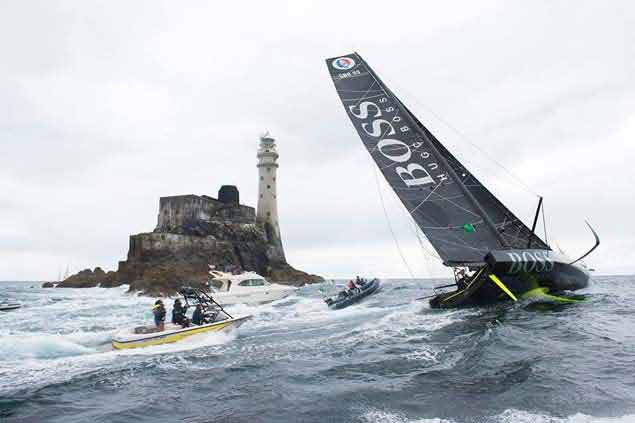 Hugo Boss with the fan club as she arrives at the Fastnet. The extreme offwind foil configuration means she makes about ten degrees of leeway when hard on the wind
Hugo Boss with the fan club as she arrives at the Fastnet. The extreme offwind foil configuration means she makes about ten degrees of leeway when hard on the wind
The problem is that with such a purpose-designed boat, the number of useful events is limited. In the interim, between races which suit, they have to make do with what’s available, so their next outing will be the Middle Sea Race on 28th October. The winds in that are notoriously all over the place, but who knows, they might get lucky, and it’s all experience even though they’re allowed to carry extra hands. But it won’t be more than three at most, as more bodies just get in the way in a cockpit optimised for one.
For Alex Thomson, the Hugo Boss sponsorship, with major support from Mercedes, is in place for 2020, but his team are willing to take in any extra interest, as the boat we were being amazed by at the Royal Irish cost a basic of €5 million, and a new one won’t be any cheaper. As for Nin O’Leary, he seems to be aiming for a boat he can initially secure for €3.6 million, but will need continuing investment thereafter.
 Stewart Hosford and Nin O’Leary
Stewart Hosford and Nin O’Leary
You cannot but be intrigued by the Hugo Boss setup. The boat looks and is the quintessential expression of modern German industry and commerce. Yet she’s sailed by a jolly Englishman whose main performance theatre is provided by France. And the technical management behind it all is provided by a peripatetic Corkman.
Into this whirling maelstrom of possbilities and challenges has stepped a 31-year-old Irish sailing star who is learning just as fast as he can by sailing as co-skipper on Hugo Boss, yet the logic is that he in time will have to think of his own boat. In fact, everybody is taking a very mature approach to this. The only relative certainty is that they’ll be doing the Middle Sea Race together in eight weeks time. Beyond that, the ideal might be the two-handed Barcelona World Race in May 2018, but if Nin O’Leary has his own boat by that time, then he’ll be going with that, and Alex Thomson will have to find another co-sailor.
It’s a world of long-term goals in which you have to be prepared for changing situations from minute to minute, or even second to second. We’re astonished by the sheer challenge of the big events, without thinking of the shoreside work. The bigger the sponsorship, the more demanding the sponsor will expect to be of the star’s time.
Set against the innocent amateur sport of Water Wag racing, the contrast was total. You really couldn’t have asked for a better way of grasping the enormity of what these guys take on.
Over a number of years, the numbers of Water Wag competing in club racing, on Wednesday evenings, has been bucking the national trend, by increasing in numbers of competitors. Hal Sisk, the 2017 Captain of the Water Wags, decided that the race for the Captain’s Prize, would be an opportunity to break the current world record for Water Wags in the same race, which currently stands at twenty-eight.
 The Royal Irish Yacht Club was abuzz with the arrival of Hugo Boss boat and the Water Wags Captain’s Prize. Photo: Amy O'Leary
The Royal Irish Yacht Club was abuzz with the arrival of Hugo Boss boat and the Water Wags Captain’s Prize. Photo: Amy O'Leary
On 30th August, the light wind was somewhat unstable, and blowing from the west. The committee, under the leadership of Tom Hudson laid a windward mark off the marina entrance, and a clever start line, long enough for thirty Water Wags, with a pin end advantage, which could have led the competitors into the lighter wind close to the shore, while those starting near the committee boat could tack away, into the last of the flood tide at the harbour mouth to their advantage. With a large fleet, one might have expected a general recall, but only two boats were recalled. At the first windward mark, the leader was Pansy, (at 111 years old, the second oldest boat competing) who had started near the pin mark, followed by Moosmie and Eva. The race was four windward-leeward laps of the harbour. At the bottom of the run, the gate marks were widely spaced. Pansy opted for the north mark, while Moosmie and Eva took the south mark, which dropped Pansy to third place at the second windward mark. It appeared that the best course was to sail up the middle of the harbour.
At the next windward mark, Swift moved up into third place. On the next run, there was a big wind shift. The boats which gybed quickly did best out of this change, which turned the north gate mark into the preferred one. At the third windward mark Tortoise was in third place. The wind was growing in strength, which brought six boats to the finish line together. They crossed the line in the following order.
1st –15, Moosmie. David MacFarlane.
2nd.– 8, Barbara, Ian & Judith Malcolm.
3rd. 33, Eva, Katie Tingle & Dermot O Flynn (Winner division 1B)
4th.. -42, Tortoise, William Prentice & Moiselle Hogan.
5th. - 38, Swift,
6th, -24, Gavotte.
7th. -46, Mademoiselle.
8th. -3, Pansy.
9th.-32, Skee.
10th. -9, Marie Louise.
11th. – 17, Coquette.
12th. – 44, Scallywag.
13th.- 18, Good Hope.
14th. 26, Nandor (Winner division 2)
15th. -6, Mary Kate.
16th. -47, Peggy.
17th. – 43, Freddie.
18th. -30, Sara.
19th. – 14, Phyllis.
20th. - 36, Little Tern.
21st. – 40, Swallow.
22nd. – 16, Penelope.
23rd. – 12, Alfa.
24th. – 20, Badger.
25th. - 4, Vela.
26th. – 31, Polly.
27th – O8, Eros.
28th. –34, Chloe.
29th – 10, Sprite.
OCS- 41, Mollie.
OCS- 45, Mariposa.
The world record attendance of 31 Water Wags was achieved, and celebrated afterwards with a dinner in the Royal Irish Yacht Club.
There is a Sport of Sailing & a Sport of Yacht Ownership
“For many people yacht ownership is enough. They buy a boat and they keep it in a marina and they don’t go sailing very often and they go there for picnics and so on, but for some people you can combine the two and you can get the best enjoyment from your boat, using it, which is the main thing.”
There is a sport of sailing and there is a sport of yacht ownership, glassfibre boats are a bit anodyne and Dublin has the classiest of boats sailing. Those are pretty strong views, but made by a man whose opinions command respect - the exponent of classic boats, yacht restoration and history, Hal Sisk, who I met as he was attending to his Water Wag, Good Hope, which he has been racing for 39 years and that he had brought to the West Cork harbour of Glandore for the Classic Boats Regatta. We discussed what is happening to yacht racing and concern that fleets have been falling off in numbers around the coast. “In 1887 Water Wags gave the world the first one-design boat and we still race them every week in Dublin Bay. When I started in the Class we had five or six racing. We had 27 last week on the water and more young people are joining the Class in which there is a great buzz. That shows what can be done in racing.”
We discussed glass fibre yachts which he considers a bit “anodyne” and doesn’t find them as interesting as the wooden classics. He pointed to the “National 18 wooden clinker boats, a fine boat,” but mostly gone from the racing scene. He contrasted this with older wooden boats still actively racing in Dublin, pointing to the Water Wages, the Howth 17s and the Glen 21s.
Hal Sisk has boundless enthusiasm for the sport which comes across in my interview with him which you can hear on this week’s Podcast. Also on the PODCAST, this Saturday is Whale Watch Day. The Irish Whale and Dolphin Group has recorded a thousand sightings of whales and dolphins this Summer, but there are fears that ‘killer whales’ could be threatened with extinction in Europe. Whale Watching locations and details are here:

LISTEN to the PODCAST:
Tom MacSweeney presents THIS ISLAND NATION programme on radio stations around Ireland
Water Wags Set Sail in Heritage Week Race at Dun Laoghaire
Heritage week runs from 19th to 27th August, and the Water Wags are part of Ireland’s heritage, and thus the race for 23rd. August was a Heritage Week event.
The wind blew force four at the beginning, so, some of the competitors were asking if we would be better reefed? The clouds above ensured that the wind would be shifty in direction.
The committee, under the leadership of Tom Hudson laid a suitably long line for the 25–boats competing. By the start of the race the wind had dropped to a kindly 10–knots which is perfect weather for Water Wags.
The fleet were quite evenly spread along the line, and those nearest to the committee boat end tacked off early to obtain benefit from the rising tide. At that stage, nobody realised what a game of snakes and ladders it would become. Over the first beat, the wind dropped down to about four knots along the marina side, while near the harbour mouth, there was no wind. Mariposa was first at the windward mark. On the first run it did not matter a bit which side one took, or which gybe. There were few gains to be made. More significant was the leeward marks.
Those who took the starboard mark remained in wind, while those who took the other mark were left out to dry. At the next windward mark the brave committee decided not to shorten the race, and to set the Water Wags on a second lap. At that stage the order was Mariposa, Little Tern, and Pansy. Again, the run offered few opportunities other than the straight line. On the third beat, the wind was offered, and as quickly taken away from the competitors. At the final windward mark the race was shortened with the order:
1st – 45, Mariposa- Cathy MacAleavey & Con Murphy.
2nd.- 36 Little Tern- Tim & Marcus Pearson.
3rd. - 3, Pansy, - Vincent Delany and Emma Webb.
4th. - 38, Swift,
5th. -24, Gavotte.
6th. -41, Mollie,
7th. – 12, Alfa.
8th. - 16, Penelope.
9th. -9 Marie Louise.
10th. -20 Badger.
11th. -42, Tortoise.
12th. -4, Vela.
13th. -18, Good Hope
14th.- 40, Swallow.
15th. -43, Freddie.
16th. – 33, Eva.
17th. -44, Scallywag.
18th. -31, Polly
19th -34, Chloe.
20th. -17, Coquette.
21st. – 30, Sara.
22nd. -15, Moosmie.
23rd.. -26, Nandor,
24th. -08, Eros.
25th. -47, Peggy.
Classic Boat Variety at Glandore Regatta
If variety is the spice of life, then the 25th Anniversary Glandore Classics Regatta is currently staging the most vibrant and flavoursome boat show on the Irish coast writes W M Nixon.
Admittedly the mid-week routine, which will lead on to events like races to Castlehaven (or Castletownshend if you prefer), doesn’t have quite the same hectic pace as the opening weekend. But for connoisseurs of classic or traditional or even just plain odd boats, it’s a feast for eye, memory and analysis which has seen some vividly contrasting boats all united in at least one purpose.
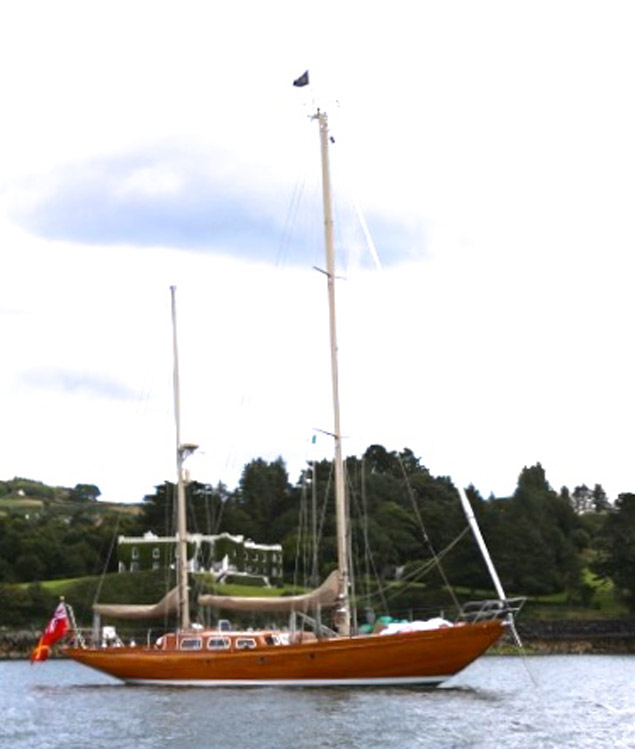 Flagship for style. The 1970 McGruer ketch Cuilaun at Glandore exemplifies the contemporary standard for classic yacht maintenance and presentation. Photo: Gary MacMahon
Flagship for style. The 1970 McGruer ketch Cuilaun at Glandore exemplifies the contemporary standard for classic yacht maintenance and presentation. Photo: Gary MacMahon
That purpose was to honour the memory and achievement of the late Theo Rye (1968-2016). He was taken from us all too soon last Autumn. But in his short life, his passion for yacht and boat design - its history and its future – was an inspiration for all who came in contact with him, and particularly those with whom he worked on a variety of projects which could range from the smallest of boats right up to the ultimate Fife restoration, the giant 23 Metre Cambria
 The CityOnes from Limerick cutting a dash with a difference at Glandore. It takes an effort to realize they were designed by Theo Rye, yet he could comfortably take such unusual challenges in his stride. Photo: Gary MacMahon
The CityOnes from Limerick cutting a dash with a difference at Glandore. It takes an effort to realize they were designed by Theo Rye, yet he could comfortably take such unusual challenges in his stride. Photo: Gary MacMahon
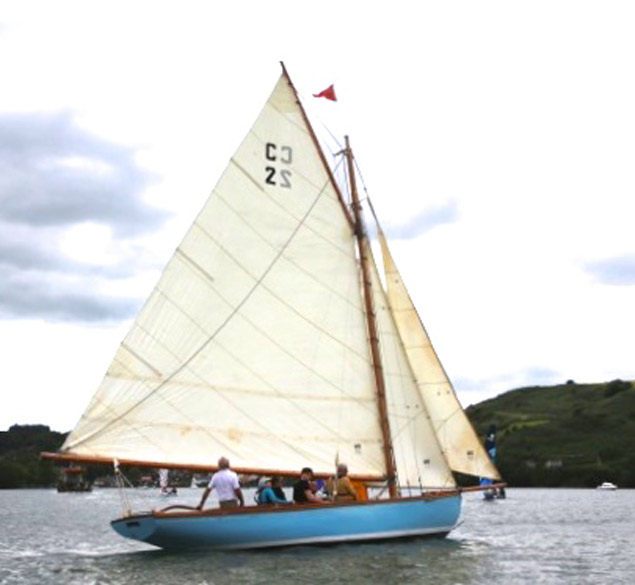 The Cork Harbour One Design Elsie (Patrick Dorgan) at Glandore. She was desined by William Fife in 1895-96. Photo: Gary MacMahon
The Cork Harbour One Design Elsie (Patrick Dorgan) at Glandore. She was desined by William Fife in 1895-96. Photo: Gary MacMahon
In Glandore, there are currently several boats which have benefitted from Theo’s expertise, or could do were it so wished. For instance, a regular at Glandore is the modernized Clyde 30 Brynoth, a Fife creation of 1905. If anyone had ever planned to bring Brynoth back to her original form, it would have been so reassuring to entrust the project to Theo’s encyclopaedic knowledge of the Fife design and build canon.
Yet the breadth of his influence and expertise is also seen in Hal Sisk’s eye-catching yet under-stated 63ft powercruiser Molly Ban, which is in Glandore to act as mothership to the owner’s Dublin Bay Water Wag. Molly Ban could be claimed to find inspiration from may sources, but she is such a unique combination of seagoing powerboat and classic dinghy mothership that we could reasonably argue she is sui generis, she’s just her own sweet self, and that’s all there is to it.
 The 63ft Molly Ban is an elegant multi-purpose vessel whose large self-draining cockpit can be used as a “deck garage” for smaller classic craft. Photo: Gary MacMahon
The 63ft Molly Ban is an elegant multi-purpose vessel whose large self-draining cockpit can be used as a “deck garage” for smaller classic craft. Photo: Gary MacMahon
In addition to the owner’s advanced technical experience, Molly Ban saw the combined talent of Nigel Irens and Theo Rye put to work to create a very elegant and distinctive vessel so easily driven that, with a single 300hp Cummins diesel, she has a maximum loaded speed of 16 knots and makes an easily-reached 14 knots on 30 litres of fuel an hour. Yet if you throttle back to 10 knots – a tidy enough speed for most cruising – she burns only ten litres an hour.
 The stern view of Molly Ban gives a hint of the ingenuity of her design. The little clinker tender is based on a dinghy built for Hals Sisk’s grandfather in 1926. Photo: Gary MacMahon
The stern view of Molly Ban gives a hint of the ingenuity of her design. The little clinker tender is based on a dinghy built for Hals Sisk’s grandfather in 1926. Photo: Gary MacMahon
There’s a completeness to the Molly Ban concept which is a credit to the memory of Theo Rye. But equally, in looking at the presentation of all the top classics at Glandore, you realize that you’re looking at yachts which have been raised to a standard which Theo and others like him ensured was set, and then adhered to, and if anything improved over time.
His mind could also produce totally off-the-wall solutions to design challenges. But though we all know that it was Theo Rye who came up with the completely innovative design for the CityOne dinghies to be built by the Ilen Boatbuilding School in Limerick, nevertheless at Glandore it was still pause for thought to see them sharing the sea with the utterly classic Dublin Bay Water Wags, a design of 1900 which Theo Rye equally cherished.
 The timeless elegance of classic clinker construction. Guy Kilroy heels his modern-build Water Wag Swift to make the best of zephyrs at Glandore. Photo: Gary MacMahon
The timeless elegance of classic clinker construction. Guy Kilroy heels his modern-build Water Wag Swift to make the best of zephyrs at Glandore. Photo: Gary MacMahon
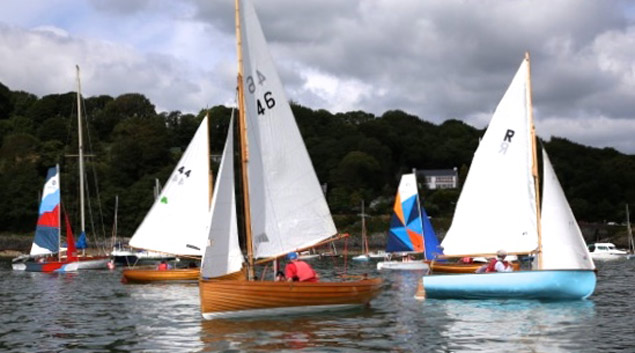 Mixing the fleets – Water Wags from Dublin Bay, CityOnes from Limerick, and a Rankin from Cork Harbour share the waters of Glandore. Photo: Gary MacMahon
Mixing the fleets – Water Wags from Dublin Bay, CityOnes from Limerick, and a Rankin from Cork Harbour share the waters of Glandore. Photo: Gary MacMahon
With four CityOne dinghies available in Glandore for an inter-area Theo Rye Memorial Series, Race Officer Donal Lynch was able to provide competition for a representative selection with crews from Limerick, the County Clare folk of Seol Sionna who had arrived in Glandore with their own distinctive Shannon Estuary hooker Sally O’Keeffe after a fine overnight passage from Kilrush, a West Cork crew with some involved in the restoration of the ketch Ilen at Oldcourt, and a Cork city team.
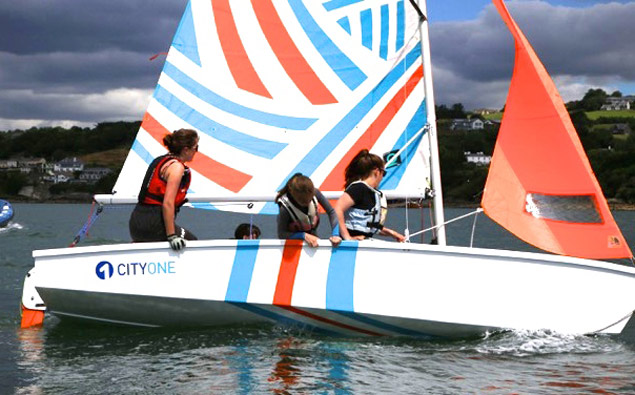 The Cork crew in the Inter-Area series for CityOnes were Nicola Cowhig (helm), Aoife & Muireann O’Donnell, and Gemma. Photo: Gary MacMahon
The Cork crew in the Inter-Area series for CityOnes were Nicola Cowhig (helm), Aoife & Muireann O’Donnell, and Gemma. Photo: Gary MacMahon
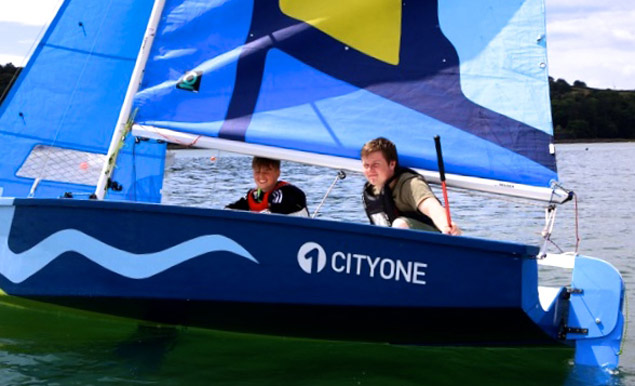 They may not look like they’re going anywere fast, but Limerick’s Donal Coffey (helm, right) and Sean McNulty won the Theo Rye Memorial Series for the CityOne dinghies. Photo: Gary MacMahon
They may not look like they’re going anywere fast, but Limerick’s Donal Coffey (helm, right) and Sean McNulty won the Theo Rye Memorial Series for the CityOne dinghies. Photo: Gary MacMahon
In the end, it was the Limerick duo of Donal Coffey (helm) crewed by Sean McNulty who won the weekend series overall, but really it was the way that the CityOne dinghies so ably fulfilled the role envisaged for them by Gary MacMahon of the Ilen School and Theo Rye which was the abiding memory.
As the photos reveal, Donal Lunch has had quite a challenge in setting races for all classes which will be manageable despite a shortage of wind, with further frustration early in the week as the underlying northerly airstream tended to negate the efforts of the warming summer days to create a sea breeze, but by week’s end we hope to get reports of improved sailing.
Meanwhile, a view of the classic style currently gracing the Glandore anchorage is more than enough to be going along with.
 “Eclectic” would be the best word for the fleet at Glandore. Photo: Gary MacMahon
“Eclectic” would be the best word for the fleet at Glandore. Photo: Gary MacMahon
Cotton Topsails Hoisted as National Yacht Club Welcomes Classic Boat Fleet for Kingstown 200 Cup
It could be over 50 years since a cotton topsail has been seen from the National Yacht Club and this afternoon as the classic fleet arrived "Peggy Bawn", a GL Watson 36–ft Cutter, built in 1894, hoisted her cotton suit of topsail and gaff main.
A temporary pontoon as been anchored off the Carlisle Pier and here the renovated Dublin Bay 24 footer "Periwinkle" this afternoon having sailed from France via the Scilly's and Greystones where some former 24 hands with long association with the class shipped on board, Chris Johnson, David Espey, Chris Craig and Terry Johnson.
On the National Yacht Club platform the Dublin Bay Mermaids were arriving by road and a fleet of "Fifes" from Royal Anglesey Yacht Club were being masted and launched having arrived by ferry.
The fleets arrival for the opening of the Volvo Dun Laoghaire Regatta and the inclusion of the classics for this edition will provide a historic spectacle from the East Pier.
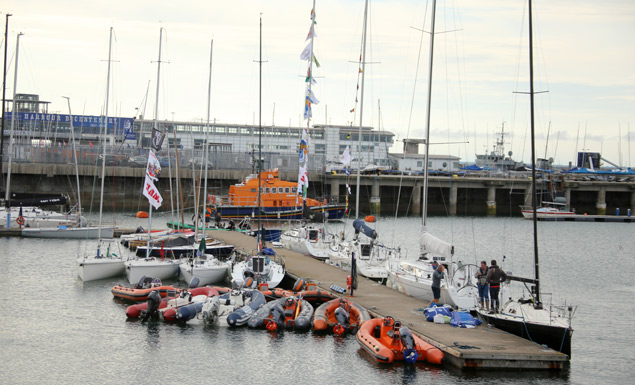 Dun Laoghaire Regatta entries line up at the National yacht club pontoon ahead of tomorrow's regatta
Dun Laoghaire Regatta entries line up at the National yacht club pontoon ahead of tomorrow's regatta
Chloe Wins Buckingham Cup As Dun Laoghaire Water Wags Are 'Discommoded By Cruise Liner'
For the second handicap race of the year, for The Buckingham Cup and The Wigham Trophy, the Dun Laoghaire Water Wags were discommoded by a 9,975 ton, 440ft long cruise liner, The Star Pride with her 208 passengers and 164 crew.
She was scheduled to leave the Carlisle Pier at 18.00hrs but there was an upset to her plans. Allegedly, a replacement part was required for her engines, which was being delivered from Dublin Port by car, leaving the latter venue at 18.00hrs. Instructions were conveyed to the Water Wags by Harbour Company officials. The reality was something different. At approx. 18.45hrs the tugboat Burfort arrived in Dun Laoghaire harbour joined by the Dublin Port harbour pilot. They set to work quickly, towed The Star Pride by the stern, until the liner was in the centre of the harbour. They then spun her, until the bow was pointing towards the harbour mouth.
The Wags quickly launched, the committee boat then laid a four-lap course with a start line near the marina entrance, and windward mark under the East Pier Lighthouse. The first Water wag to start was Nandor, followed half a minute later by Chloe, and Coquette, Polly and Scallywag two minutes later. Last to start after the passage of six minutes were Moosmie, Gavotte, Swift, Tortoise and Eva.
As the race developed the early starters merged with some of those faster boats attacking from behind. It soon became clear that the leaders, mother and daughter team of Kate & Amy O’Leary in Chloe and Mc Bride & McBean in Nandor were in for a great battle. A similar battle developed between Hal Sisk and Sue Westrup in Good Hope and Ian Magowan in the recently restored Mary Kate. At the finish, the order was:
1st – 34, Chloe. Kate & Amy O’Leary
2nd. -26, Nandor, Brian McBride and Stuart McBean
3rd.- 6, Mary Kate, Ian & Jenny Magowan
4th. -18, Good Hope
5th. -46, Mademoiselle
6th. - 3, Pansy
7th. -Moosmie
8th. - 38, Swift
9th. - 10, Sprite
10th. -30 Sara
11th. -45, Mariposa
12th. -42, Tortoise
13th. -17, Coquette
The Collen Cup is a new perpetual trophy which has been in the Collen family since 1907 and will be awarded to the overall winner of the Water Wag Class within the Classic section of this and subsequent Volvo Dun Laoghaire Regattas.
The Trophy will be presented by Pamela Collen, on this, the 207th year of the Collen families’ Construction business and on the occasion of the 200th anniversary of the Dun Laoghaire construction commencement.
The Collen Family has had a long association with The Royal Irish Yacht Club. Lyal Collen who married Euphemia Adelaide Falkiner (a daughter of past Commodore Dr. Ninian Falkiner) was an active member throughout his life. The Collen Cup is in honour of Euphemia Adelaide Falkiner, mother of Neil Collen, current Chairman of the firm, who sailed in the Water Wag fleet on Shindilla in the 1950s and 1960s.
Sharing a bicentenary with Dun Laoghaire Harbour, Collen is a main sponsor of the 2017 Volvo Dun Laoghaire Regatta.
It’s probably more than a little sacrilegious to suggest that, as some of the rituals of a global religion are built around The Last Supper, then it’s not at all unreasonable for the world’s oldest One-Design sailing class to have its rituals built around The First Picnic writes W M Nixon.
But the thought springs irresistibly to mind on seeing the first image of the Dublin Bay Water Wags settling into their new home for the week, southern Brittany’s incomparable inland sea of the Morbihan, currently en fete with a fleet of 1400 craft of all sizes for the biennial Festival of Sail which has been getting under way today.
The Dublin Bay Water Wags make up just 1% of the fleet, with fourteen boats present. But that’s not bad going for a class founded in 1887. Admittedly the boats now in France are of a type introduced to the class in 1900, yet that still makes them older than most other boats present, though not the two Howth 17s Leila and Aura of 1898 vintage, there in France with four other newer boats of their class
It was when the two Irish classes finally met up today that the Water Wags were found having a picnic. Not a very organized one admittedly, and definitely not Glyndeburne style, as it was little more than a lunch stop at a handy beach.

The First Picnic. Midsummer’s Day 1887, and the Water Wags (of the original 13ft type) are gathering at Dalkey Island. Photo courtesy Water Wags
Nevertheless it sparked thoughts of The First Picnic, which was held on Dalkey Island on Midsummer’s Day, June 21st 1887, when the Water Wags were in their first year, and were sailing the little double-ended 13ft dinghies that were the basis of the class for their first dozen years.
It was combined with a “cruise” from what was then Kingstown Harbour to celebrate Queen Victoria’s Golden Jubilee. And as the photos from Alfred & Vincent Delany’s excellent history of the Water Wag class reveal, Victorian picnics were not something to be undertaken lightly. This is Serious Fun in a tradition which the class have continued ever since. So they’ll probably be very offended by any thought that this photo just in from the Morbihan suggests for even a nano-second that they’re having a picnic.
 These are Serious Picnic People – the Water Wag Class members and guests on Dalkey island, June 21st 1887. Photo courtesy Water Wags
These are Serious Picnic People – the Water Wag Class members and guests on Dalkey island, June 21st 1887. Photo courtesy Water Wags
Les Wags de L’eau a la Semaine de Golfe de Morbihan
Over the next few days fourteen Water Wags will head by ferry to France to participate in one of the greatest classic boat regattas in Europe. As Afloat.ie reported previously, one thousand four hundred and forty two traditional workboats and recreational boats will head to Brittany from Britain, Ireland, Netherlands, Belgium, Switzerland, Austria, Czech Republic, Spain, and Japan.
Among the 19 yachts of the Irish contingent travelling to the celebration of traditional yachting are:
Waterwags: 9, Marie Louise (1927), 17, Coquette (1909), 31, Polly (1984), 32, Skee (1985), 33, Eva (1986), 34, Chloe (1991), 38, Swift (2001), 40, Swallow (2003), 41, Molllie (2005), 44, Scallywag (2009), 45, Mariposa (2015).
Howth 17 ft: Aura (1898), Deilginis (1905), Eileen (1908), Gladys (1907), Leila (1898), Silvermoon (1898).
Others: Anna Panna, a Mcmillan gaff cutter. Sylvana, Moody 46 and possibly the only boat which will sail to the event instead of being trailed.
What a celebration of Irish craftmanship it will be.
































